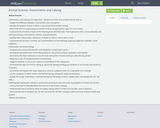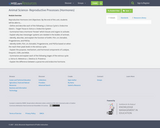
Insemination and Calving Unit Objectives – By the end of this unit, students will be able to…- Explain the difference between insemination and conception.- Identify the window of time in which a cow should be bred after calving.- Determine when it is appropriate to breed a cow by recognizing the signs of a cow in heat.- Summarize the function of each of the following heat detection aids: heat expectancy chart, mount detection aid,tailhead markings, heat detector animals, and pedometers.- Identify when insemination should occur based on when a cow is seen in heat.- Summarize the purpose, function, use, and limitations of the following pregnancy detection methods: rectal palpation,ultrasounds, and blood testing.- Compare and contrast the benefits and drawbacks of twinning in cattle.- Summarize and define each of the following terms: dry period, lactation, gestation, and mastitis.- Summarize the steps necessary to dry off a cow and prevent mastitis during or after the dry period.- Diagnose a case of mastitis based on its symptoms.- Diagnose whether or not a cow is about to calve based on her symptoms.- Summarize the signs of normal calving vs. abnormal calving and diagnose whether or not human intervention isnecessary.- Summarize and explain the steps required to conduct a physical exam on a cow while she is calving.- List the situations in which human intervention during calving will always be necessary.- Explain the proper intervention methods during the following scenarios: upside down calf, backwards calf, calf with ahead/leg bent backwards, calf that is positioned correctly but has not made any progress in at least 30 minutes.- Summarize how to manually dilate the cervix of a cow to aid in calving.- Demonstrate how to properly utilize and apply calving chains in order to assist with cases of dystocia.- Demonstrate how to properly care for the cow and the calf after calving in order to ensure maximal health and preventdisease and infection.
- Subject:
- Agriculture, Food and Natural Resources
- Material Type:
- Module
- Author:
- Jennifer Russell
- Date Added:
- 08/14/2018
